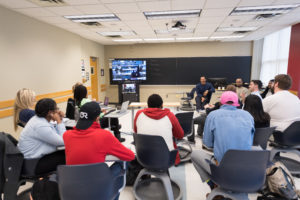
Pauline Jones, director of the University of Michigan International Institute, is passionate about the need for education around some of the most complex topics in the world like Islam.
“Islam is much more than a religion. It’s also a civilization, a variety of cultural traditions and sometimes a basis for political ideologies,” she said. “Islam is not just predominant in the Middle East, but also in Africa and Asia. Its diversity, complexity and geographical expansiveness makes it nearly impossible for one university to offer enough courses to cover it all.”
To fill the gaps in education, U-M has taken the lead in coordinating with several other universities in the Big Ten Academic Alliance to establish the Digital Islamic Studies Curriculum. The initiative allows students to take courses about Islam not offered at their own institutions.
This cross-university class was made possible with a $3 million Andrew W. Mellon Foundation grant awarded in 2014 to Jones when she was director of the Islamic Studies Program.
Mirror image, separated by miles
The class in U-M’s Haven Hall is just getting started and it’s hard to miss the oversized screen in the middle of the classroom. It’s almost a mirror as students at the University of Iowa take their seats and peer out from the screen.
The classrooms are separated by 450 miles, but all the students are enrolled in the same “Islam in Africa” class taught at U-M.
As they settle in, Rudolph Ware, U-M associate professor of history, launches into a discussion of 19th-century Senegal. “We will divide the class into four groups,” he tells them. Students break out into clusters of Muridiyya or Sufis, French colonialists, clerics and peasants.
Students from the University of Iowa join some U-M students to create the peasant group. They debate the issues most important to them, interacting in real time. By the end of the class, the peasants on both sides of the screen must pledge allegiance to one of the three other groups.
Last year, Iowa and University of Minnesota students enrolled in Ware’s class. He said that students want to learn about Islam, but they don’t always have the opportunity.
“There is a lot of misinformation about Islam and Muslims around the world,” he said. “There is a real need for students to understand the human diversity within the religion.”
U-M senior Adam Megeed said he likes the experimental dimension of the class and its immersive approach.
“I like everything about the class,” he said. “It is eye-opening to see the subject matter and hear the discussions from different perspectives.”
But he also likes the in-person interaction with the professor before and after the class, when he can take the discussion a little further.
Expanding opportunities
In the last few years, more than 250 students across 10 universities have taken courses through DISC.
Jones recognizes that interpersonal interactions with faculty are an important component of the curriculum. As part of teaching a DISC course, instructors at the host university are required to take at least one trip to the receiving university and teach the course from there.
“It is different from a recorded lecture, it is active learning,” Jones said. “The students interact with the professor and other students. Thanks to the grant, there is also a graduate-student instructor available at the receiving university to help them with the course material.”
Those participating graduate students walk away with benefits and learning experiences too, said Ware, who has graduate students from Gambia and Uganda assisting him. They enrich the coursework with their perspectives and also help grade papers, give exams, answer questions and staff office hours, he said.
Jones said a key goal when establishing DISC was to ensure the curriculum would offer enough classes so students at participating universities could complete a minor—and possibly even a major—in Islamic Studies.
“Pennsylvania State University is now considering offering a minor in Islamic Studies in spring, something that would not have been possible without DISC courses,” said Jonathan Brockopp, associate professor of history and religious studies at Penn State.
He has taught “The Crusades” class through DISC with Michigan State University as the receiving university.
Teaching a course that spans multiple campuses requires more than just technical savvy, Brockopp said. Of course, the class requires the right technology and real-time technical support. But it is up to the professor to ensure that the students at each campus are receiving a quality experience.
“If the students and the teachers are not aware or comfortable, there might be a learning curve associated with teaching and receiving the course,” he said.
Ideal model
Slowly but surely interest in this kind of academic innovative idea is growing. In the fall, Rutgers University will offer “Islam in Africa,” and four universities, including U-M, are registered to receive it.
Ware said that an imam from Cedar Rapids, Iowa, took the class last semester and said he uses the lessons everyday.
Jones considers DISC to be a great model for offering shared courses on thematic areas that are global in nature, such as human rights, environmental sustainability and peace and conflict.
“These topics make it difficult for a single university to have all the resources and offer a full curriculum on its own,” she said.
At its core, she said DISC is helping to demystify Islam.
“It’s important to give students a real sense of how diverse Islam is, both as a religion and culture as it is practiced on the ground,” she said.




